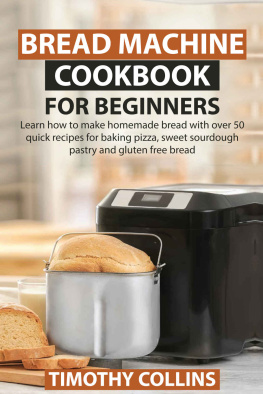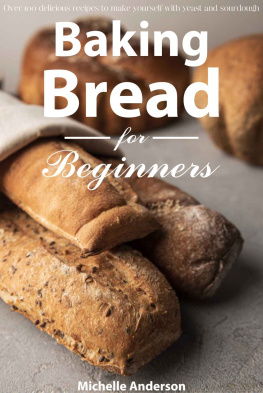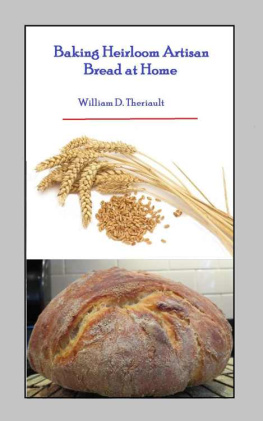Artisan Bread
Baking
_________________________________________________________________
Handcrafted Illustrated Bread Cookbook with No-Fuss Recipes for Perfect Homemade Breads

Julia Korenivska
Dedication
To my parents
For raising me to believe that anything was possible
And to my family
For making everything possible
Copyright 2021 by Julia Korenivska
All rights reserved.
No part of this book may be reproduced in any form or by any electronic or mechanical means, except in the case of a brief quotation embodied in articles or reviews, without written permission from its publisher.
Disclaimer
The recipes and information in this book are provided for educational purposes only. Please, always consult a licensed professional before making changes in your lifestyle or diet. The author and publisher shall have neither liability nor responsibility to anyone with respect to any loss or damage caused or alleged to be caused directly or indirectly by the information contained in this book. All trademarks and brands within this book are for clarifying purposes only and are owned by owners themselves, not affiliated with this document.
Contents
Introduction
Since time immemorial, human beings have been enjoying bread. Bread traces its history to Ancient Egypt, where the first bread was made around 8000 BC. In those days, grain was crushed using stone as a grinding tool, and the bakers made what we now commonly recognize as tortillas (Mexico) or chapati (India), or flat bread.
Egyptians leveraged their beer brewing expertise and the warm climate to produce the worlds first sourdough by combining wild yeast with the bread mixture. In the following centuries, the use of bread continued to spread across different countries, with different communities developing their own versions of bread. For instance, after inventing the water mill in 450 BC, Romans took up bread making as an art and at some point even consumed bread as a status symbol. Wheat bread was beloved by the rich, while the poor ate barley bread.

Fast-forwarding to today, bread is consumed not only to provide our bodies with much needed fiber but also for its pre-biotic properties. In fact, bread has amassed a huge following of enthusiastic fans, especially the true disciples of the gluten-free and low-carb diet trend.
How is Bread Formed?
Bread is the end product of mixing flour, yeast, salt, and water. It is formed by first mixing the dry ingredients before adding the wet ones.
The mixture is then kneaded by hand or with an electric mixer to form dough. With that said, using an electric mixer is more advantageous as it not only saves time but also facilitates the formation of gluten, resulting in much better dough.
After kneading, the next process in bread formation entails leaving the dough in an oiled bowl and covering it for 1 2 hours, depending on the room temperature. This process allows the yeast to do its work and letting the dough rise.
The next process in called proofing and it is usually done after the dough has finished rising. It entails punching the dough to release any air pockets that have developed to ensure you have a consistent dough texture. Once done proofing, gently shape your dough into a ball and allow it to rise again for an additional 3045 minutes.
After that, the dough is ready to be baked for 30 to 45 minutes, depending on the side of your dough and the cooking temperatures. It's the baking that turns the dough into an aromatic loaf of delicious bread. Once ready, allow it to cool in the banking pan for 10 to 15 minutes and then transfer to a cooling rack to finish cooling.
Dough Mixing Methods
There are three major dough mixing methods. They include;
Direct Dough
Also commonly referred to as straight dough method, direct dough is primarily used when you want to prepare lean yeast doughs without any fat. The direct dough mixing method is quick and streamlined, making it one of the most widely used methods for commercial bread making.
Starter Dough or Pre-Fermented
Another commonly used mixing method entails using a starter dough or pre-fermented dough. Basically, starter dough is a stable mixture of wild yeast and beneficial bacteria that is regular refreshed, and it is mainly used to flavor and leaven future dough. If properly maintained, the starter dough can continue indefinitely, allowing you to continue enjoying countless of naturally leavened loaves of bread and other baked goods.
Pre Cooked Dough
Pre-cooked frozen dough is an excellent option if you are looking to save time and money. This ready-to-go dough is mainly sold in frozen or refrigerated sections of the grocery stores, and it will help you prepare homemade bread within minutes, as it doesnt require any stirring, rising, and baking from-scratch.
To Knead or Not to Knead

The whole idea behind kneading dough is to form gluten. Basically, gluten is formed when water combines with glutenin and gliadin, which are the two of the major proteins found in wheat flour. Traditionally, kneading entails pressing, folding, and stretching your dough, which helps the different protein parts to merge and align. The more you continue kneading, the more gluten you have. This process is particularly important in the bread making process, as it helps the gluten to trap the gasses produced by the yeast, ultimately
No-Knead Bread
If kneading helps line up proteins and form gluten, it seems contradictory that no-knead bread can still form light, fluffy loaves. However, gluten can form naturally by allowing the dough to ferment for 12 or more hours. This tactic gives both the yeast and the enzymes enough time to work their magic.
The enzymes within the flour break down the proteins, allowing the gas produced by the yeast to inflate the dough and make it rise. Think of it as a slow-motion kneading. If you have the time, fermentation provides a no-fuss option for creating a perfect loaf. The acidification of this process makes the bread easier to digest and sometimes tolerated by those with gluten sensitivities.
Types of Flour
There are several types of flour that you can use for baking. In the interest of time, however, we are going to look at three major types;
All-Purpose Flour
All-purpose flour is refined flour, and it is the most commonly used flour. It comes from whole wheat in which the bran is removed, leaving behind the innermost part of the wheat. This results in a much softer flour stripped of its natural nutrients. However, AP flours usually come enriched with vitamins and minerals.
Self-Rising Flour
Self-rising flour is basically all-purpose flour with a leavening agent, such as baking powder, added.
Whole Wheat Flour
Another type of flour is the whole wheat flour. It is unrefined and rich in fiber and considered healthier than all-purposed flour. Along with that, it also contains bran and wheat germ, which gives it its unique brown color and added nutritional value.
Top 5 Baking Tips
As earlier indicated, baking is an art. As such, there are several tips to keep in mind to ensure you get the very best results.








